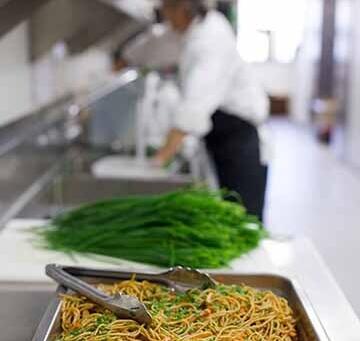
An Introduction to the New Lunch Box Website
Key new content, COVID support, and Q&A with Beth Collins
July 30, 2020 | By Danielle Eliser
We are so excited to debut this overhaul of The Lunch Box! Our new and improved site supports school districts as they navigate going back to school and look towards the future of their meal programs. We hope the site will continue to support districts in serving healthy food, even during alternative meal programs. The Lunch Box (TLB) is school food’s trusted source for scratch cooking—including free resource downloads and hundreds of tried and tested school food recipes—and we are excited to share the new content and refreshed look with you!
Our team has been hard at work for the last year, building new content, resources, and materials. Here are some of our favorite new areas to explore:
- COVID-19 Resources & Support - we’re here to help, with the most up-to-date resources, links, and current info
- New Recipes section - new recipes & platform for easier searching & scaling
- Central Kitchen case study - read through this operational profile of BVSD’s central kitchen to better understand what goes into building and operating a central kitchen
- Sustainable Lunchrooms - sustainable practices for any school kitchen
We’ve also connected with Beth Collins, one of our operational experts and general brain behind TLB, to chat about her experience rebuilding the site and how COVID has changed school food.
What excites and draws you to school food?
BC: In 2000, I moved from restaurant-based cooking and management to feeding children sort of by accident. When I found the Ross School, I was more interested in the kitchen and procurement aspect of the program, and the concept of feeding children. What I quickly learned is that feeding kids enhanced my interest in sustainable and local agriculture with the larger purpose of educating children on the benefits of eating “real” food. I described it back then as “cooking for a cause.” I don’t think I could ever return to restaurants after that experience.
Thinking back to when you were building TLB originally in 2008, and now revising it for the third time, how have you seen school food change in the last 12 years?
BC: I believe that school food has made some headway into accepting and promoting fresh, whole foods. To some degree, that was assisted by the implementation of the Healthy, Hunger-Free Kids Act (HHFKA) of 2010. As the regulations were implemented by districts in 2012 and districts universally shifted to food-based menu planning, we saw more awareness of how to offer more “fresh” in school menus, and more acceptance of salad bars as an efficient way to offer vegetable sub-groups. The USDA embraced Farm to School during this period, offering more competitive grants and creating more resources for school districts. The other important improvement resulting from HHFKA was establishing the Professional Standards for food service teams from the state office level to the various district sizes. This has promoted more professionalism and emphasis on training, which is certainly important for any district that might want to take on scratch-cooking.
With the recent COVID pandemic, how can the new TLB site help school food professionals currently?
BC: Many organizations are offering resources to assist operational and financial planning for school food service during the pandemic, but because of the differences from locale to locale, state to state - I don’t believe there’s a one-size fits all approach. Directors are being tasked to make decisions and change plans as district administrative teams keep pivoting depending on the COVID intensity in their areas. Districts responded in March within 2 days- shifting from congregate to non-congregate dining and continued to adjust operations as the pandemic heated up. School food service teams have learned tons in the last five months and are bringing all that learning to the table as they create operations plans for August and September openings. It’s a fluid situation and the directors are getting it done. For TLB, we know we cannot provide one set of solutions that will work for every district, so it’s important for us to gather and highlight the most current resources for districts to determine what is best for them.
School districts have had to pivot their feeding plans due to COVID; are you concerned about the role of scratch-cooking in schools amidst the current pandemic?
BC: Having to bag or package meals challenges efficiency throughout the operation, but that has not stopped many teams from scratch-cooking and packaging those foods for distribution. We’ve seen many approaches to maintaining high quality choices despite various ways districts are distributing. Teams are making complex salads, cooking and chilling items for families to reheat at home. Some districts are even offering the ingredients themselves with recipes for finishing at home. Directors are creative and are maintaining their relationships with local growers who also have been hit with the effects of the pandemic.
How do you think schools can continue to incorporate fresh fruits and veggies in their menus, even with alternative feeding?
BC: There is no limitation to packing out fruits and veggies, but there has been leniency in the waivers with regard to vegetable sub-groups which may drive a little less variety. Overall, I believe that packing out cold fresh fruits and veggies is better than offering french fries so in that regard, packing out meals might be the winner. Some directors are taking advantage of individual packaging that produce processors can offer, if they can afford that. Making the finances balance in this situation is very difficult, so balancing labor and food costs when the meal counts are below norm is really important.
Do you have any tips for school districts juggling uncertainties about the upcoming school year?
BC: Make sure you are at the table where decisions are being made for your district.
We can’t predict the future, but how do you think we can best support school food professionals in the next 5 years?
BC: We will need to see what happens post-pandemic. I think the impact of this pandemic will be felt for the next decade and will greatly impact the educational environment, including school food service.







